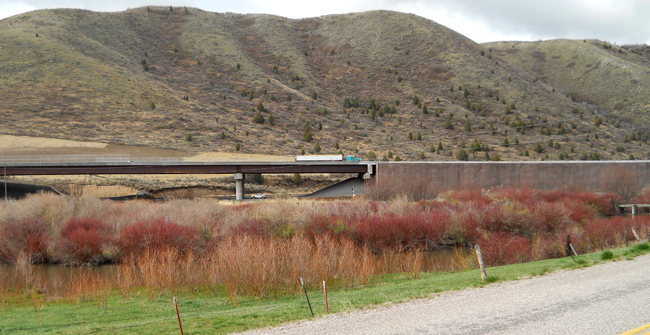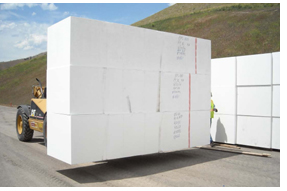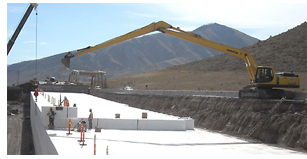

D5's use of geofoam in Topaz Bridge still paying dividends
An award-winning, innovative construction process using unique fill material debuted on the GARVEE-driven U.S. 30 Topaz Bridge project in southeastern Idaho five years ago. With 2010 solidly in the rearview mirror, it is worth taking a look back at the initiative. The Topaz Bridge project featured great collaboration between innovative engineering and construction techniques.
Construction of the new 606-foot-long Topaz Bridge over the Union Pacific Railroad and Portneuf Marsh Valley Cana,l east of McCammon, incorporated large high-density foam blocks as fill material for the bridge approaches. High water content in the old riverbed made the soil under the west bridge approach unstable. The weight of typical construction materials would make the fill susceptible to settlement and compromise the highway, so engineers turned to high-density foam, called Expanded Polystyrene (EPS) or "Geofoam,” as an alternative – the first such application in Idaho.
“Maintenance costs are zero for now,” said Resident Engineer Scott Redding. “One of the best things about foam is that it doesn’t disintegrate. Rather than clogging up landfills, we can use it under our roads.”
Building the four-lane bridge incorporated blocks of foam fill that were about four feet wide, four feet high, seven to 14 feet long and weighed 200 to 400 pounds each — 100 times lighter than conventional fill material. Geofoam is a lightweight, rigid, foam plastic that weighs as little as a pound per cubic foot and is made up of 98 percent air voids. The fill reaches 30 feet in height, 500 feet in length and contains the equivalent of 22,000 cubic yards of foam blocks. Placing the blocks took about two months. The lightweight, very strong blocks are pictured at left.
“Conventional fill would have been cheaper and faster initially, but the detrimental impacts to the river and surrounding wetlands and the constant maintenance of differential settlement, makes this innovative technique one of our ‘best transportation department in the nation’ initiatives a tried and true example,” Redding explained.
“A little more initial investment now (time and money), produces huge gains in what ITD can accomplish for its long-term mission and goals,” he added.
Every layer was placed perpendicular to the one below it in a Lego-type overlapping pattern, and contractors used steel plates with teeth on both sides to help tie the blocks together. A Mechanical Stabilized Earth (MSE) wall – wire “cages” filled with gravel — was built on top of the lightweight fill to retain the roadway gravel and pavement. The exposed geofoam was then covered with shotcrete – “sprayed concrete.” The shotcrete covering protects the foam from damage by foraging animals and ultraviolet rays. The picture below shows crews using the new foam blocks to build the bridge and wall in 2009.
The use of Geofoam reduced construction time, lessened impacts to road users and reduced wetland mitigation because construction required a smaller roadway footprint.

“Most importantly,” Redding said, “the cost to road users if ITD had to wait for regular fill to settle as we built up the roadway was about $7,700 per day.”
Geo-Strata magazine, a publication of the American Society of Civil Engineers focused on unique construction techniques, featured the project in a Sepember. 2011 issue. The project also won the 2012 Excellence in Transportation award in Construction.
Five years later,
maintenance costs on this innovative project are nil and “It still rides very smoothly,” Redding added.
Published 10-30-15